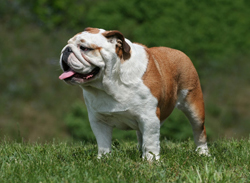Bulldogs are medium-sized dogs with short and stocky bodies. Their coat comes in brindle, fawn, white, red, piebald, or fallow, and it's smooth, short, straight, and glossy. There is no fringe, curl, or feathering. These dogs are known for their waddle and wrinkles. Their eyes are dark and round, and they have high-set ears. These dogs have a very short face and muzzle and a large, black nose. Bulldogs measure 12 to 16 inches and weigh 40 to 50 pounds.
Because of their short noses, Bulldogs are prone to overheating. This physical trait also results in snoring and wheezing, and it may make it difficult for these dogs to breathe.
This gentle and protective breed forms a strong bond with children, making them a good choice for families. They aren't very active dogs and are great companion animals for couch potatoes and apartment dwellers. They also do well with seniors.
Most people will recognize the Bulldog as the mascot for the University of Georgia. Dogs from the same line of English Bulldogs, under the name of Uga, serve as the school's mascot, and each receives his own university ID and watches games from inside an air-conditioned doghouse.
Bulldogs are clever, comical, and affectionate dogs that are good with children and other pets. They do have a stubborn streak and can be pushy when they want something, such as attention. These dogs really don't like taking no for an answer, and they can become annoying very quickly when they decide they aren't backing down.
Generally, Bulldogs are patient, tolerant, adaptable, and affectionate, but they are rarely in the mood for play. Instead, these dogs usually prefer to hang out on the floor or couch next to their human family members. They enjoy a bit of cuddling and a lot of petting, but they should not be expected to roll around or play games. Their calm and affectionate nature makes them a good choice for seniors who want a loyal and loving dog that does not require a lot of physical activity.
Bulldogs love attention, and they seem to draw it naturally everywhere they go. These dogs will become depressed or destructive if neglected or left alone for long periods. Bulldogs must live indoors with their human family.
Bulldogs are known to suffer from a variety of health conditions, including congenital hip dysplasia, elbow dysplasia, stenotic nares, an elongated soft palate, shoulder luxation, patellar luxation, spine and hip malformations, inverted eyelids, dry eye, cataracts, entropion, ectropion, distichiasis, and cherry eye, which is a congenital disorder of the third eyelid that causes the membrane to prolapse and protrude from the eye.
Routine veterinary care, vaccinations, proper nutrition, and prompt treatment of health conditions help ensure Bulldogs live 8 to 10 years.
Although these dogs are typically very obedient, they can be stubborn and difficult to train. Training is best done when the Bulldog is still a puppy. Adult Bulldogs are considerably more mellow than puppies, but they are also less cooperative and less interested in training sessions.
These dogs usually get along very well with other dogs, and play dates with other Bulldogs are a healthy way for the breed to get much-needed socialization. The level of attention these dogs demand can be overwhelming, and providing the Bulldog with a companion can take some pressure off human family members. Having two Bulldogs of the opposite sex (with both spayed/neutered) is ideal.
Because Bulldogs like to chew, providing them with plenty of chew toys can keep them busy and keep their teeth off the furniture. Tolerating bad behavior just helps ensure it will continue. These dogs need firm and consistent rules.
The Bulldog's coat is low-maintenance and can be kept shiny and healthy with a quick brushing every few days with a soft bristle brush or rubber curry brush. These dogs don't shed very much, and loose and dead hair is manageable during shedding seasons with an extra brushing per week. Bathing is rarely necessary.
Bulldogs tend to drool a lot and they need their facial and nose wrinkles wiped clean and dried every day. Any crud or moisture between the skin folds should be wiped away with a damp cloth, and the skin must be thoroughly dried to prevent the growth of fungi and bacteria. At the same time, the skin should be checked for signs of existing infection or irritation.
The teeth should be brushed regularly to freshen the breath and prevent gum disease and tooth decay, and the nails need clipping every few weeks. The ears should be checked for excess wax accumulation every week. Any signs of ear infection, such as redness, odor, or discharge, should be reported to a veterinarian right away.
Bulldogs likely originated in the British Isles. The "bull" in the breed's name comes from their association with bull baiting, which involved a dog attacking and grabbing a bull by its nose and refusing to let go. Although it began as a way to bring bulls in for castration or breeding, this practice was primarily a form of entertainment at its peak, during the 13th century.
After bull-baiting was outlawed in 1835, breeders attempted to use Bulldogs as fighting dogs. While the breed's insensitivity to pain, courage, and ferociousness made it a formidable opponent, fights between two Bulldogs were rarely entertaining and people quickly lost interest.
Fanciers in England then started breeding the dog to eliminate the fierce characteristics the breed had become known for. It is now a very agreeable breed. In addition to being a beloved companion animal, the Bulldog is the official mascot of the U.S. Marine Corps.
The American Kennel Club officially recognized the Bulldog in 1886.

